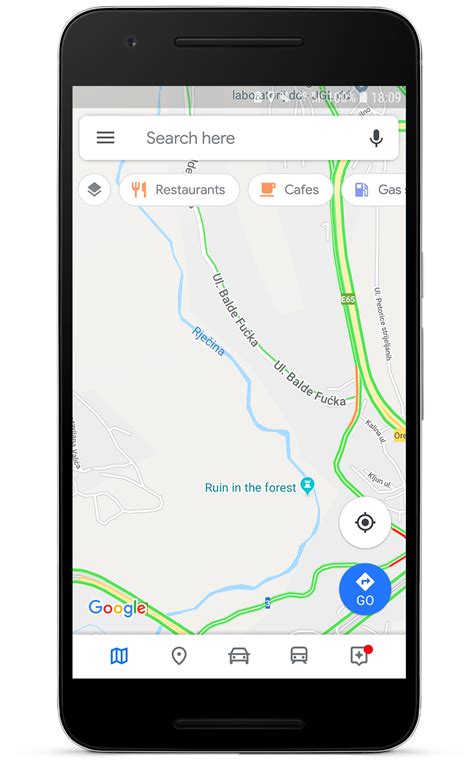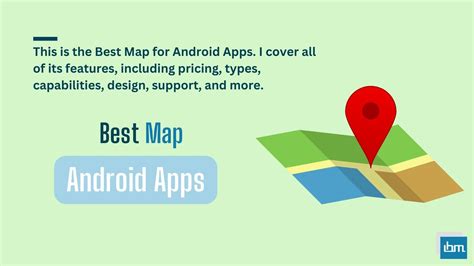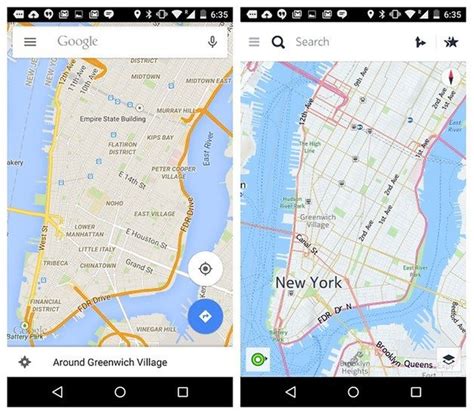Android Map Applications

Welcome to the ultimate guide on Android map applications! In today's world, where navigation and location-based services have become an integral part of our daily lives, understanding the capabilities and features of Android mapping apps is essential. This comprehensive article will delve into the intricacies of Android map applications, exploring their development, functionalities, and real-world applications.
The Evolution of Android Map Applications

Android map applications have come a long way since their early days. From basic GPS navigation systems to highly sophisticated mapping tools, the evolution has been remarkable. Let’s take a journey through time to understand how Android map apps have transformed our mobile experiences.
Early GPS Navigation
The roots of Android map applications can be traced back to the early days of GPS navigation. Back then, mobile navigation systems were limited to turn-by-turn directions and basic map displays. These early devices relied on pre-installed maps and lacked real-time updates, making them less reliable for dynamic routing.
One of the pioneering Android map applications was Google Maps, which made its debut in 2005. Google Maps revolutionized the industry by offering free, real-time traffic updates and detailed maps with satellite imagery. It quickly became a go-to navigation tool for many Android users, setting the stage for the future of mapping apps.
The Rise of Mapping Services
As Android gained popularity, the demand for advanced mapping services grew. Developers recognized the potential and began creating innovative mapping applications, each with unique features and target audiences.
During this period, we witnessed the emergence of various mapping apps, such as Waze, which focused on community-based traffic updates and real-time navigation. Waze's crowd-sourced approach allowed users to report incidents, accidents, and traffic jams, providing a dynamic and interactive mapping experience.
Another notable entrant was Here WeGo, a mapping service developed by Nokia. Here WeGo offered offline maps, making it ideal for travelers and users in areas with limited internet connectivity. The ability to download maps and navigate without an internet connection was a game-changer for many Android users.
Integration and Innovation
As Android map applications matured, developers started integrating various services and features to enhance the user experience. Location-based services became an integral part of many apps, enabling users to discover nearby places, restaurants, and points of interest with ease.
The introduction of augmented reality (AR) technology brought a whole new dimension to Android map apps. Apps like Google Maps and Pokemon GO utilized AR to provide immersive navigation experiences. With AR, users could visualize directions and points of interest overlaid on the real-world environment, making navigation more intuitive and engaging.
Additionally, voice-guided navigation became a standard feature, allowing hands-free and eyes-free navigation, which proved to be a significant safety enhancement for drivers.
Key Features and Functionalities

Android map applications offer a wide range of features and functionalities, catering to diverse user needs. Let’s explore some of the most prominent features and their impact on the user experience.
Real-Time Navigation and Traffic Updates
One of the cornerstone features of Android map apps is real-time navigation and traffic updates. These apps utilize advanced algorithms and data sources to provide users with the most efficient routes, taking into account current traffic conditions.
By analyzing real-time traffic data, map applications can suggest alternative routes, helping users avoid congestion and save time. This dynamic routing capability has become a lifesaver for commuters and travelers alike, ensuring a smoother and more efficient journey.
| Mapping App | Real-Time Traffic Updates |
|---|---|
| Google Maps | Utilizes crowd-sourced data and sensors to provide accurate traffic information. |
| Waze | Relies on user-reported incidents and real-time traffic updates for accurate routing. |
| Apple Maps | Uses machine learning and crowd-sourced data to offer real-time traffic conditions. |

Voice-Guided Navigation
Voice-guided navigation has revolutionized the way we navigate. Android map apps now offer turn-by-turn voice instructions, allowing users to keep their eyes on the road and hands on the wheel. This feature has significantly improved safety and convenience, especially for drivers.
Voice guidance provides clear and precise directions, announcing upcoming turns, exits, and road names. It ensures that users stay on course, even in unfamiliar areas or during complex maneuvers.
Offline Mapping and Downloadable Maps
Offline mapping has become a crucial feature for Android map applications, especially for travelers and users in areas with limited internet access. The ability to download and store maps locally ensures uninterrupted navigation, even in remote locations.
Android map apps like Maps.me and City Maps 2Go offer extensive offline mapping capabilities, allowing users to download maps for entire countries or specific regions. This feature is particularly beneficial for outdoor enthusiasts, hikers, and travelers who rely on their devices for navigation in off-grid locations.
Location-Based Services and Points of Interest
Android map applications have seamlessly integrated location-based services, enabling users to discover nearby places, businesses, and points of interest. Whether it’s finding the nearest coffee shop, locating a specific landmark, or exploring hidden gems, map apps have become indispensable tools for local exploration.
These apps utilize advanced algorithms and user-generated content to provide personalized recommendations based on user preferences and location. From discovering new restaurants to exploring local attractions, Android map apps have transformed the way we discover and engage with our surroundings.
Augmented Reality (AR) Navigation
Augmented reality technology has brought a new level of immersion to Android map applications. AR navigation overlays digital information onto the real-world environment, providing a unique and intuitive navigation experience.
With AR navigation, users can visualize their route, points of interest, and directions directly on their device's camera view. This feature is particularly useful in complex urban environments, helping users navigate busy streets and find their destinations with ease.
Apps like Google Maps AR and Pokemon GO have popularized AR navigation, showcasing its potential to enhance user engagement and make navigation more enjoyable.
Industry Use Cases and Real-World Applications
Android map applications have found their way into various industries, revolutionizing the way businesses operate and enhancing user experiences. Let’s explore some real-world applications and use cases.
Transportation and Logistics
Android map applications have become an indispensable tool for transportation and logistics companies. From ride-sharing services to delivery fleets, map apps provide real-time tracking, route optimization, and efficient dispatch management.
Ride-sharing apps like Uber and Lyft utilize Android map applications to connect riders with drivers, providing accurate ETAs and real-time tracking. Delivery services, such as Doordash and Instacart, rely on map apps to optimize routes and ensure timely deliveries.
Travel and Tourism
Android map applications have transformed the travel and tourism industry, empowering travelers with comprehensive navigation and exploration tools. From planning trips to discovering hidden gems, map apps have become essential companions for travelers.
Travel guide apps like TripAdvisor and Lonely Planet integrate Android map applications to provide users with detailed travel information, including locations of attractions, restaurants, and accommodation. These apps enable travelers to explore destinations like never before, making their journeys more immersive and enjoyable.
Outdoor Activities and Adventures
Android map applications have revolutionized outdoor activities, from hiking and camping to off-road adventures. With offline mapping and detailed terrain information, map apps provide essential tools for outdoor enthusiasts.
Apps like AllTrails and Backcountry Navigator offer trail maps, GPS tracking, and navigation for hikers and backpackers. For off-road enthusiasts, apps like Offroad Navigator and OSMAnd provide detailed maps and routing for exploring remote areas, ensuring a safe and enjoyable experience.
Real Estate and Property Search
Android map applications have also found their way into the real estate industry, providing an efficient way to search for properties and explore neighborhoods. Real estate apps utilize mapping technology to showcase property listings, allowing users to visualize locations and nearby amenities.
Apps like Zillow and Redfin integrate Android map applications to provide users with an immersive property search experience. Users can explore neighborhoods, view property details, and even take virtual tours, all within the app.
Future Trends and Innovations
The future of Android map applications holds exciting possibilities and innovations. As technology advances, developers are exploring new ways to enhance the user experience and leverage the potential of mapping technology.
Advanced Machine Learning and AI
Machine learning and artificial intelligence (AI) are expected to play a significant role in the future of Android map applications. Developers are exploring ways to utilize AI for more accurate and personalized recommendations, route planning, and traffic predictions.
With AI, map applications can learn user preferences, travel patterns, and behavior, allowing for more tailored and efficient navigation experiences. AI-powered features, such as predictive routing and personalized travel suggestions, are likely to become mainstream in the coming years.
Integration with Wearables and Smart Devices
The integration of Android map applications with wearables and smart devices is another area of focus. Developers are exploring ways to seamlessly connect map apps with smartwatches, fitness trackers, and smart home devices.
With wearables, map apps can provide hands-free navigation, allowing users to receive turn-by-turn directions and notifications directly on their wrists. Smart home integration can enable voice-activated navigation, making it even more convenient to plan and execute trips.
Enhanced AR and VR Experiences
Augmented reality and virtual reality (VR) technologies are expected to play a more prominent role in Android map applications. Developers are working on creating immersive AR and VR experiences, providing users with a new level of engagement and interactivity.
AR-powered map applications could offer virtual tours of cities, landmarks, and attractions, allowing users to explore destinations in a completely new way. VR integration could enable virtual reality navigation, providing a realistic and immersive experience for travelers and explorers.
Environmental and Sustainability Focus
With growing concerns about environmental sustainability, Android map applications are expected to incorporate eco-friendly features. Developers are exploring ways to promote eco-conscious travel and transportation choices.
Map apps could provide users with eco-friendly route options, considering factors like traffic congestion, fuel efficiency, and carbon footprint. By promoting sustainable travel practices, Android map applications can contribute to a greener and more environmentally conscious future.
Conclusion

Android map applications have evolved from simple GPS navigation tools to sophisticated mapping platforms, offering a wide range of features and functionalities. From real-time navigation and traffic updates to immersive AR experiences, these apps have transformed the way we navigate and explore our world.
With ongoing advancements in technology and a focus on user experience, the future of Android map applications looks promising. As developers continue to innovate and integrate cutting-edge technologies, we can expect even more immersive, efficient, and environmentally conscious mapping solutions.
Whether it's for daily commutes, travel adventures, or business operations, Android map applications have become indispensable tools, empowering users with the information and guidance they need to navigate their surroundings confidently and efficiently.
How accurate are Android map applications in terms of real-time traffic updates?
+Android map applications utilize various data sources to provide real-time traffic updates. These sources include crowd-sourced data, sensors, and machine learning algorithms. While the accuracy can vary based on the app and region, leading mapping apps like Google Maps and Waze have proven to be highly reliable in providing up-to-date traffic information.
Can I use Android map applications offline?
+Yes, many Android map applications offer offline mapping capabilities. Users can download maps for specific regions or countries, allowing them to navigate and access maps without an internet connection. This feature is particularly useful for travelers and outdoor enthusiasts in areas with limited connectivity.
Are Android map applications secure and privacy-focused?
+Android map applications prioritize user privacy and security. Reputable mapping apps have robust privacy policies and data protection measures in place. They allow users to control their data sharing preferences and often provide options to disable certain features, ensuring a secure and personalized experience.



